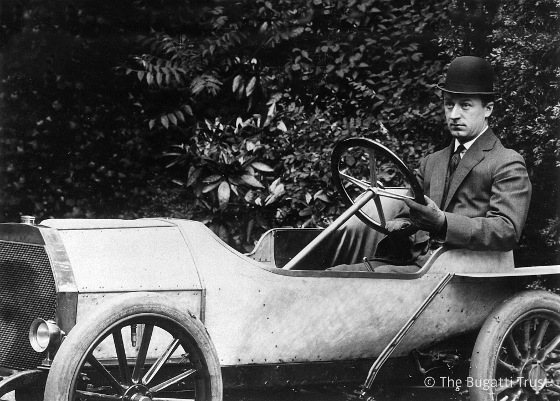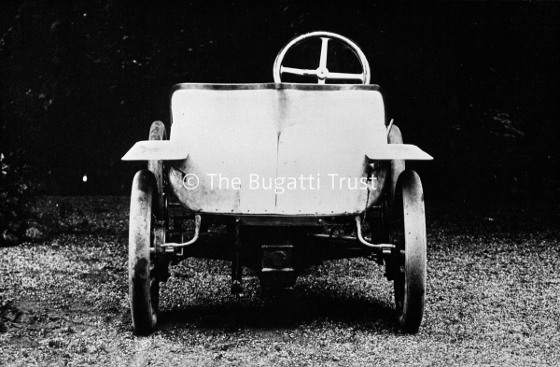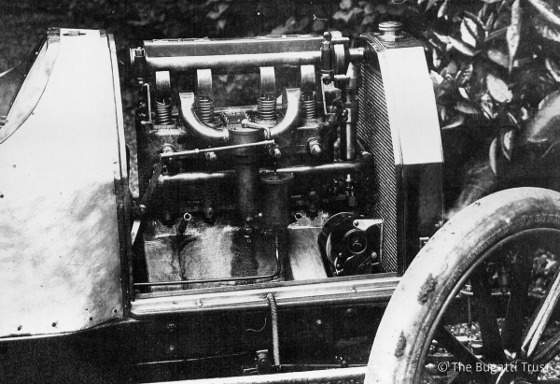 |
| December 26, 2018 | Volume 14 Issue 48 |
Designfax weekly eMagazine
Archives
Partners
Manufacturing Center
Product Spotlight
Modern Applications News
Metalworking Ideas For
Today's Job Shops
Tooling and Production
Strategies for large
metalworking plants
Classic History: Type 10 -- The first Bugatti

The Bugatti Type 10: Ettore Bugatti's first car.
The first real Bugatti, the Type 10, was conceived more than 100 years ago.
When Ettore Bugatti started to develop a new car in 1908, his goals were clear. The Type 10 was to be small, lightweight, and agile -- as well as sufficiently powerful to win races. His first Bugatti not only had to keep up with the competition, but it also to be better in every respect.
At the beginning of the 20th century, this was a new approach. Up to then, vehicles had engines with large displacements, between 4 and 12 liters, and were very heavy, which meant that they were rather unwieldy.
The Type 10 broke with this tradition, and it looked almost like a sports car -- comparatively speaking -- from the future. It was a smart racing car with function following form, without any compromises. Aesthetics and design were already important for Bugatti more than a century ago.
Ettore Bugatti, born in Milan, Italy, in 1881, had been designing vehicles for some time. Initially he worked for well-known brands of the time such as De Dietrich and E.C.C Mathis, before joining Gasmotoren-Fabrik Deutz AG of Cologne in 1907. This was the company that had been co-founded by inventor and developer Nikolaus-August Otto in 1864. At the beginning of the 20th century, Deutz wanted to produce cars under license, and young Ettore Bugatti became head of the production department.
Near to the factory in Germany, Bugatti moved into a villa in the Mühlheim District of Cologne on the right bank of the Rhine. At that time, he also worked on some of his own projects. With his own employees, he started to design a car of his own from 1908 onward. Only the raw materials came from Deutz.

The Bugatti Type 10: Ettore Bugatti's first car
Although Bugatti was still employed by Deutz and only registered his name as a trademark later, the Type 10 is considered to be his first independent design -- and therefore the first Bugatti, heralding the birth of the brand.
In 1909, the "Pur Sang" (thoroughbred) had been finished. A 1.2-liter four-cylinder engine with 10 PS accelerated the two-seater, which weighed only 365 kg, to a top speed of 80 km/h. The overhead camshaft operated two valves per cylinder suspended in a cast-iron block, an innovation at the time. The camshaft was connected to the crankshaft via a vertical bevel shaft. The power was transmitted from the engine to the rear wheels via a multi-plate clutch and a drive shaft. At the time, when most cars were equipped with chain drive, this was an advanced solution.
Leaf springs absorbed the hardest bumps, and cable brakes provided deceleration. The rectangular radiator dominated the front end. It was only over the course of many years that the Bugatti radiator eventually adopted its unique and distinctive rounded-top horseshoe shape.

The Bugatti Type 10 engine.
Bugatti's Type 10 was praised by the experts. When pioneering French aviator Louis Blériot drove the Type 10 at an air display in Cologne, he was thrilled. He pleaded with Ettore Bugatti to produce a series of these cars.
With the assistance of partners such as Pierre de Vizcaya, Bugatti opened his own firm in an old tannery in Molsheim at the end of 1909. Previously, he had successfully negotiated a loan with Darmstädter Bank for the production of 10 cars and five aero engines. Following the termination of his contract with Deutz, a close collaborator of Bugatti drove the Type 10 to Strasbourg, an eight-hour drive at the time. On Jan. 1, 1910, Bugatti officially signed the tenancy agreement for his factory in Molsheim.
Following his move, Bugatti continued to develop the Type 10 with his team, calling the modified car the Type 13 and using the Bugatti name for the first time. The four-cylinder with a displacement of 1.4 liters had a power output of 15 PS and boosted the open Type 13 to a top speed of over 90 km/h.
But Ettore Bugatti remained faithful to his original Type 10, and he never thought of selling it. Thirty or so years later, in 1939, he still owned the car, which was used by his wife, Barbara, for everyday driving.
When the Germans occupied Alsace in the World War II, Bugatti took the Type 10 to his boatyard in Bordeaux, France, where he designed speedboats. Following Ettore Bugatti's death in 1947, the car was left in a neglected state near Bordeaux until it was discovered in dilapidated condition by a French racing driver at the end of the 1940s, restored, and sold to a British collector. He sold the car to a private collection in the United States, who restored it again. The chassis, axles, and wheels were painted a reddish orange color, while the body remained silver-grey. The car is still in the collection and can also be driven, but it is only on public display on rare occasions. When it can be viewed and even driven, the light weight, speed, and power of the car are still thrilling, 110 years after it was made.
And it is that collection of characteristics that forms the cornerstone of the Bugatti brand today, 110 years later.
Source: Bugatti Automobiles S.A.S.
Published December 2018
Rate this article
View our terms of use and privacy policy
